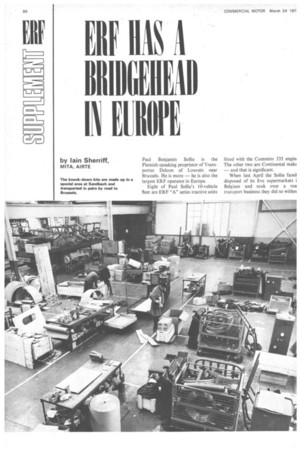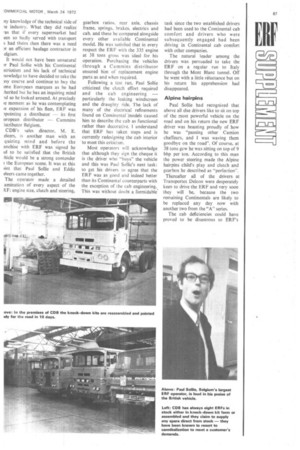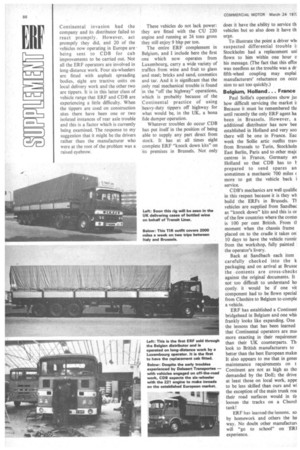BF HAS MOWN IN EUROPE
Page 88

Page 89

Page 90

If you've noticed an error in this article please click here to report it so we can fix it.
Paul Benjamin Sollie is the Flemish-speaking proprietor of Transposies Deleon of Louvein near Brussels. He is more — he is also the largest ERF operator in Europe.
Eight of Paul Sollie's 10-vehicle fleet are ERF "A" series tractive units fitted with the Cummins 335 engin' The other two are Continental makc — and that is significant.
When last April the Sollie famil disposed of its five supermarkets i Belgium and took over a roa transport business they did so withoi ny knowledge of the technical side of -le industry. What they did realize as that if every supermarket had een so badly served with transport s had theirs then there was a need )1an efficient haulage contractor in elgium.
It would not have been unnatural )r Paul Sollie with his Continental atriotism and his lack of technical nowledge to have decided to take the isy course and continue to buy the tme European marques as he had iherited but he has an inquiring mind -1c1 so he looked around. At precisely te moment as he was contemplating ie expansion of his fleet, ERF was 'pointing a distributor — its first uropean distributor — Cummins istributor Belgium.
CDB's sales director, M. E. deers, is another man with an quiring mind and before the anchise with ERF was signed he id to be satisfied that the British ;hide would be a strong contender the European scene. It was at this Mit that Paul Sollie and Eddie eleers came together.
The operator made a detailed .amination of every aspect of the R.F: engine size, clutch and steering, gearbox ratios, rear axle, chassis frame, springs, brakes, electrics and cab, and these he compared alongside every other available Continental model. He was satisfied that in every respect the ERF with the 335 engine at 38 tons gross was ideal for his operation. Purchasing the vehicles through a Cummins distributor ensured him of replacement engine parts as and when required.
Following a test run. Paul Sollie criticized the clutch effort required and the cab engineering -particularly the leaking windscreen and the draughty ride. The lack of many of the electrical refinements found on Continental Models caused him to describe the cab as functional rather than decorative. I understand that ERF has taken steps and is currently redesigning the cab interior to meet this criticism.
Most operators will acknowledge that although they sign the cheque it is the driver who "buys" the vehicle and this was Paul Soflies next task: to get his drivers to agree that the ERE was as good and indeed better than its Continental counterparts with the exception of the cab engineering., This was without doubt a formidable'
task since the two established drivers had been used to the Continental cab comfort and drivers who were subsequently engaged had been driving in Continental cab comfort with other companies.
The natural leader among the drivers was persuaded to take the ERF on a regular run to Italy through the Mont Blanc tunnel. Off he went with a little reluctanc6 but on his return his apprehension had disappeared.
Alpine hairpins Paul Sollie had recognized that above all else drivers like to sit on top of the most powerful vehicle on the road and on his return the new ERF driver was boasting proudly of how he was "passing other Camion chaffeurs, and I was waving them goodbye on the road". Of course, at 38 tons gcw he was sitting on top of 9 bhp per ton. According to this man the power steering made the Alpine hairpins child's play and clutch and gearbox he described as "perfection'' Thereafter all of the drivers at Transportes Deleon were desperately keen to drive the ERF and very soon they will be, because the two remaining Continentals are likely to be replaced any day now with another two from the "A" series.
The cab deficiencies could have proved to be disastrous to ERF's
Continental invasion had the company and its distributor failed to react promptly. However, act promptly they did, and 20 of the vehicles now operating in Europe arebeing sent to CDB for cab improvements to be carried out. Not all the ERF operators are involved in long-distance work. Four six-wheelers are fitted with asphalt spreading bodies, eight are tractive units on local delivery work and the other two are tippers. It is in this latter class of vehicle range that ERF and CDB are experiencing a little difficulty. When the tippers are used on construction sites there have been one or two isolated instances of rear axle trouble and this is a factor which is currently being examined. The response to my suggestion that it might be the drivers rather than the manufacturer who were at the root of the problem was a raised eyebrow.
These vehicles do not lack power: they are fitted with the CU 220 engine and running at 26 tons gross they still enjoy 9 bhp per ton.
The entire ERF complement in Belgium, and I include here the first one which now operates from Luxembourg, carry a wide variety of traffics from wine and fruit to glass and steel; bricks and sand, cosmetics and tar. And it is significant that the only real mechanical trouble is found in the "off the highway" operations, which is probably because of the Continental practice of using heavy-duty tippers off highway for what would be, in the UK, a bona fide dumper operation.
Whatever troubles do occur CDB has put itself in the position of being able to supply any part direct from stock. It has at all times eight complete ERF "knock down kits" on its premises in Brussels. Not only does it have the ability to service th vehicles but so also does it have th urge.
To illustrate the point a driver whi suspected differential trouble ii Stockholm had a replacement uni flown to him within one hour a his message. (The fact that this effot was needless as the trouble was a dr fifth-wheel coupling may explai. manufacturers' reluctance on ma sion to act too quickly.)
Belgium, Holland... France Paul Sollie's operations show jw how difficult servicing the market Because it must be remembered thE until recently the only ERF agent ha been in Brussels. However, a additional distributor has now bee established in Holland and very soo there will be one in France. Eac week the Sallie attic outfits travi from Brussels to Turin, Stockholn East Berlin, Paris and to other majc centres in France, Germany an Holland so that CDB has to b prepared to send spares an sometimes a mechanic 700 miles ( more to get the vehicle back i service.
CDB's mechanics are well qualifie in this respect because it is they wb build the ERFs in Brussels. T1 vehicles are supplied from Sandbac as "knock down" kits and this is or of the few countries where the conte is 100 per cent British. From tt moment when the chassis frame placed on to the cradle it takes on' 10 days to have the vehicle runnir from the workshop, fully painted the operator's livery.
Back at Sandbach each item carefully checked into the k packaging and on arrival at Brusse the contents are cross-checkt against the original documents. It not too difficult to understand ho costly it would be if one vit component had to be flown special from Cheshire to Belgium to comple a vehicle.
ERF has established a Continent bridgehead in Belgium and one whi4 frankly looks like expanding. One the lessons that has been learned that Continental operators are ma more exacting in their requiremen than their UK counterparts. Thi look to British manufacturers to better than the best European make It also appears to me that in genet maintenance requirements on t Continent are not as high as the demanded by the DoE; the drive at least those on local work, appe to be less skilled than ours and wi the exception of the main trunk roa their road surfaces would in tit loosen the tracks on a Churcl tank!
ERF has learned the lessons, so by homework and others the ha way. No doubt other manufactun will "go to school" on 'ER1 experience.




















































































































































